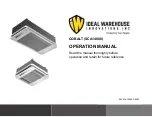
Installation manual
28
8. TRIAL RUN
8.3 Fill the name of connected system
8.1 Inspection and confirmation before
commissioning
1) Check and confirm that refrigeration pipe line and
communication wire with indoor and main unit have been
connected to the same refrigeration system. Otherwise,
operation troubles shall happen.
To clearly identify the connected systems between two or
more indoor units and main unit, select names for every
system and record them on the nameplate on the main
electric control box cover.
2) Power voltage is within ±10% of rated voltage.
3) Check and confirm that the power wire and control wire are
correctly connected.
4) Before powering on, confirm there is no short circuit to
Model (indoor unit)
Room Name
Eg: Indoor unit (A) of the
first system on second
floor
is recorded as:-2F-1A
each line.
Fig.8-1
5) Check whether all units have passed nitrogen
pressure-keeping test for 24 hours with R410A: 40kg/cm
2
.
8.4 Caution on refrigerant leakage
6) Confirm whether the system to debugging has been carried
out vacuum drying and packed with refrigeration as
required.
7) Make sure all the water pipelines are correct, including the
installation directions of water filter and water flow switch.
8) Check whether the water filter has been blocked, and clean
the filter screen. If it is seriously blocked, then it should be
checked whether the water quality has meet the
requirements.
1) This air conditioner adopts R410A as refrigerant, which is
safe and noncombustible.
2)
The room for air conditioner should be big enough that
refrigerant leakage can not reach the critical thickness.
Besides this, you can take some action on time.
3)
Critical thickness-----the max thickness of Freon without
any harm to person. R410A critical thickness:0.3 [ kg/m
3
]
9) Open the gate valve, make sure the double-pipe heat
exchanger have been filled with circulating water, and open
the water pump and air discharge valve, after make sure
the air in the water pipelines and unit has been drain out
and then close the air discharge valve.
10) Check whether the pressure meters in the water inlet and
water return pips of the unit, thermometer, water flow
switch etc. work normally, and make sure the water
pipelines system operate normal, and the water flow is
suitable.
8.2 Preparation before debugging
Main unit
Indoor unit
Room full of leaking refrigerant
(All the refrigerant has leaked)
Fig.8-2
1) Calculating the additional refrigerant quantity for each set
of unit according to the actual length of liquid pipe.
4) Calculate the critical thickness through following steps,
and take necessary actions.
2) Keep required refrigerant ready.
3) Keep system plan, system piping diagram and control
wiring diagram ready.
Calculate the sum of the charge volume (A[kg])
Total refrigerant volume=refrigerant volume when
delivered (namsuperaddition
4) Record the setting address code on the system plan.
Calculate the indoor cubage (B[m
3
]) (as the minimum
5) Turn on power switches main unit in advance, and keep
connected for above 12 hours so that heater heating up
refrigerant oil in compressor.
cubage)
Calculate the refrigerant thickness.
A [ kg]
6) Turn on air pipe stop valve, liquid pipe stop valve, oil
balance valve and air balance valve totally. If the above
valves do not be turned on totally, the unit should be
damaged.
7) Check whether the power phase sequence of main unit is
correct.
8) All dial switch to indoor and main unit have been set
according to the Technical Requirement of Product.
B [ m
3
] ≤ Critical thickness˖ 0.3 [kg/m
3
]
5)
Countermeasure against over high thickness
Install mechanical ventilator to reduce the refrigerant
thickness under critical level. (ventilate regularly)
Install leakage detector alarming device related to
mechanical ventilator if you can not regularly ventilate.



































